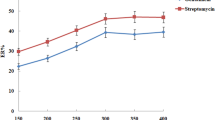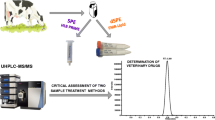Abstract.
Supported liquid membranes (SLMs) have been used in a sample pre-treatment and/or clean-up technique for the continuous extraction of a mixture of three macrolide compounds, namely tylosin tartrate, erythromycin and spiramycin from different biomatrices. The matrices from which extraction was done include cow’s milk, bovine kidney, and liver tissues. The supported liquid membrane used to trap these compounds was made up of 1-decanol:n-undecane (1:1). Several factors affecting the extraction efficiency during SLM enrichment, such as donor pH, acceptor buffer pH, and enrichment time were studied. High performance liquid chromatography coupled to a mass spectrometer operating in electrospray mode was used as a detection method for these antibiotic compounds with their minor structural components. Fragmentation behavior in ESI-MS (full scan) and ESI-MS/MS modes for these compounds has been studied, and the data obtained was used in selected ion monitoring after LC/MS. The detection limits obtained were 0.01 ppb for tylosin tartrate, 0.03 ppb for erythromycin and 0.08 ppb for spiramycin.
Similar content being viewed by others
Author information
Authors and Affiliations
Corresponding author
Rights and permissions
About this article
Cite this article
Makudali Msagati, T., Nindi, M. The Use of Supported Liquid Membranes in the Extraction of Macrolides in Biomatrices. Microchim. Acta 148, 199–214 (2004). https://doi.org/10.1007/s00604-004-0262-y
Received:
Accepted:
Published:
Issue Date:
DOI: https://doi.org/10.1007/s00604-004-0262-y




